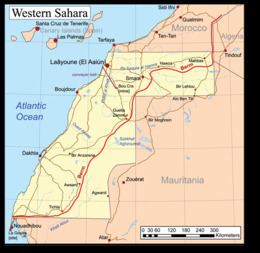Continent Africa Area Ranked 78th | Coastline 1,110 km (690 mi) | |
 | ||
Highest point unnamed elevation605 m | ||
Western Sahara is a territory in Northern Africa, bordered by the North Atlantic Ocean, Morocco proper, Algeria (Tindouf region), and Mauritania. Geographic coordinates: 24°30′N 13°00′W
Contents
Size
Total: 266,060 km², about the size of Colorado
land: 266,000 km²water: 0 km²The peninsula in the extreme southwest, with the city of Lagouira, is called Ras Nouadhibou, Cap Blanc, or Cabo Blanco. The eastern side is part of Mauritania.
Maritime claims: contingent upon resolution of sovereignty issue
Terrain
The terrain is mostly low, flat desert with large areas of rocky or sandy surfaces rising to small mountains in south and northeast.
Elevation extremes:
Lowest point: Sebjet Tah, −55 m, a depression in the northwest part of Western Sahara straddling the Morocco borderHighest point: Tikhzoukhane, 605 m, at 27° 38' 44 N 10° 44' 20 W; there are no higher SRTM values than the 605 here. This mountain range name and the "605" spot height appear on the detailed 1991 1:100,000 scale topographic (20 meter contour interval) Carte du Maroc (Aydar sheet; NG-29-XX-3) by the Conservation Fonciere et des Travaux Topographiques, Division de la Cartographie, Rabat.Natural resources
Phosphates, iron ore, and fishing resources on Atlantic Ocean coast
Land use
Arable land: 0.02%
permanent crops: 0%
other: 99.98% (2005)
Irrigated land: NA km²
Natural hazards
Hot, dry, dust/sand-laden sirocco wind can occur during winter and spring; widespread harmattan haze exists 60% of time, often severely restricting visibility. Flash flooding occurs during spring months.
Climate
Western Sahara has a hot desert climate (Köppen climate classification BWh). Annual average rainfall is below 50 mm (1,96 in) everywhere. Along the Atlantic coast, averages high and low temperatures are constant and very moderated throughout the year because cool offshore ocean currents considerably cool off the climate, especially during the day. However, summertime is long and extremely hot and wintertime is short and very warm to truly hot further in the interior, where cooling marine influences aren't felt anymore. Average high temperatures exceed 40 °C (104 °F) in summer during a prolonged period of time but can reach as high as 50 °C (122 °F) or even more in places such as Smara, Tichla, Bir Gandus, Bir Anzarane, Aghouinite, Aousserd and others. Average high temperatures exceed 20 °C (68 °F) in winter but average low temperatures can drop to 7 °C (44.6 °F) in some places. The sky is usually clear and bright throughout the year and sunny weather is the norm.
Current issues
Sparse water and lack of arable land.
Extreme points
This is a list of the extreme points of Western Sahara, the points that are farther north, south, east or west than any other location.
